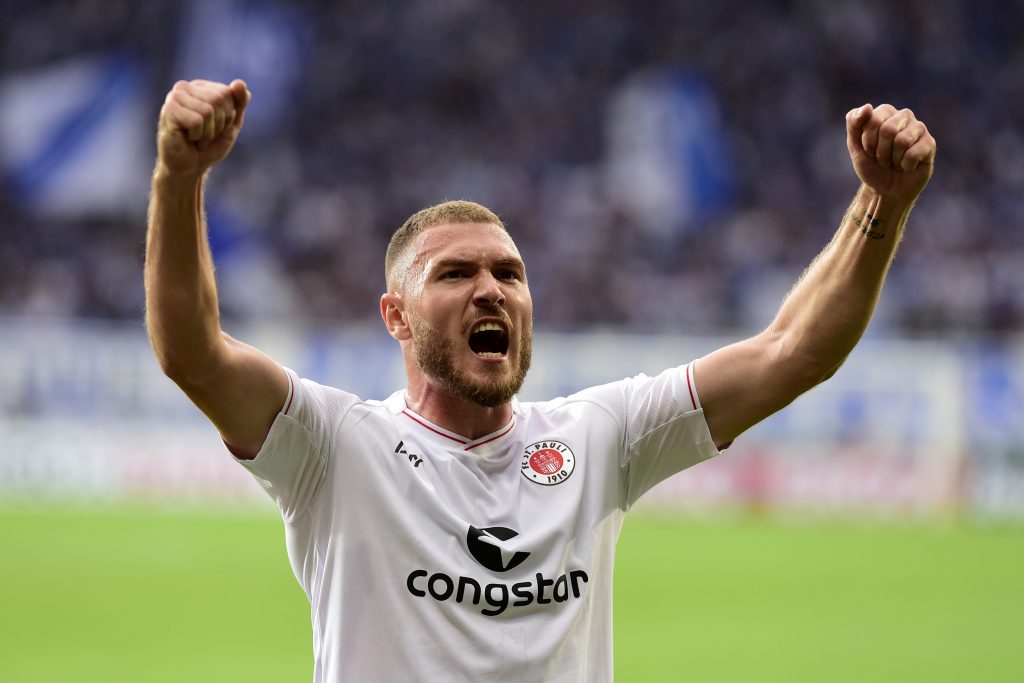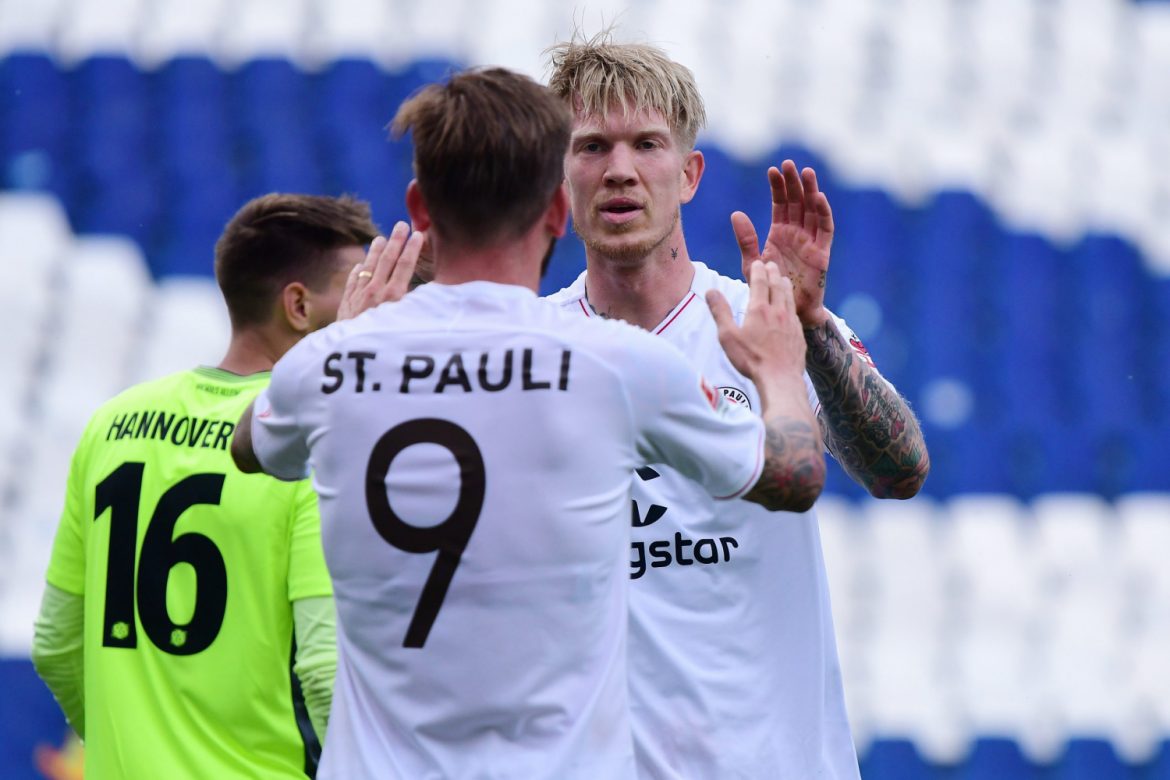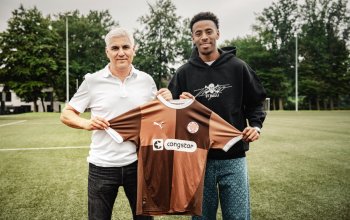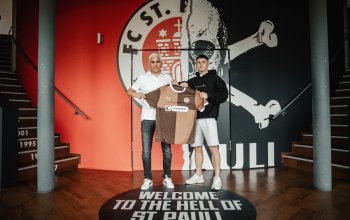In der Vorbereitung und zum Saisonauftakt stand Simon Makienok beim FC St. Pauli auf dem Platz. Im zweiten Spiel gegen Erzgebirge Aue saß er auf der Bank. Eine Woche später im Pokal war er wieder Teil der Startelf. Dieses Hin und Her hat weniger mit seiner Leistung zu tun, sondern mehr mit den Spielertypen, die der FCSP im Sturmzentrum benötigt.
(Titelbild: Peter Böhmer)
Das der Stellenwert von Stürmern nur an der Anzahl ihrer Tore ermittelt wird, ist grober Unfug. Das ist spätestens seit der Zeit von Lennart Thy beim FC St. Pauli auch hier weithin bekannt. Klar ist aber auch, dass das Toreschießen ein zentrales Kriterium ist und Stürmer auch weiterhin daran gemessen werden. Die Anforderungsprofile sind aber inzwischen erheblich vielfältiger geworden. Vielfältig ist auch die Zusammensetzung des Kaders des FC St. Pauli auf dieser Position.
Wandspieler? Konterspieler? Strafraumstürmer?
Der FC St. Pauli hat sechs Stürmer in seinem Kader: Guido Burgstaller, Simon Makienok, Maximilian Dittgen, Etienne Amenyido, Daniel-Kofi Kyereh und Igor Matanović. Jeder dieser Spieler bringt ganz unterschiedliche Eigenschaften mit sich. Das ist auf der einen Seite nicht ganz optimal, da z.B. bei einer Verletzung ein direkter Ersatz fehlt. Auf der anderen Seite bietet diese Vielfalt dem Trainer-Team die Möglichkeit das eigene Spiel ganz individuell an den jeweiligen Gegner anzupassen. Mit so einer Anpassung ist z.B. auch der Startelf-Einsatz von Maximilian Dittgen in Aue zu erklären, wie Timo Schultz nach dem Spiel berichtete. Leider sind die Möglichkeiten aufgrund der Verletzungen von Amenyido und Matanović derzeit arg eingeschränkt. Trotzdem bieten sich mit Maximilian Dittgen und Simon Makienok zwei fast gegensätzliche Spielertypen für die Position neben Guido Burgstaller an.
Dittgen ist eher ein Konterstürmer, bringt enormes Tempo mit und kann dadurch auch im Pressing eine wichtige Rolle spielen. Simon Makienok kann eher als eine Art Wandspieler agieren, da er nicht nur Ziel für lange Bälle ist, sondern mit solidem Passspiel diese auch weiterleiten kann. Schultz hob auf der PK nach dem Spiel hervor, dass Erzgebirge Aue enorm viele Sprints absolviert und daher einen laufstarken Spieler auf der Position neben Burgstaller benötigte – die Wahl fiel daher auf Dittgen. Weniger Power im Anlaufen, mehr Passsicherheit und auch die Option „langer Ball“ wurde dann gegen Magdeburg benötigt, weshalb Makienok wieder in die Startelf rotierte.
Dieser Unterschied drückt sich nach zwei Spielen auch ziemlich krass in den Statistiken aus: Simon Makienok hat bisher pro 90 Minuten über 15 Kopfballduelle bestritten (viertmeiste der Liga), Dittgen nur ein einziges. Auf der anderen Seite hat Makienok noch kein einziges Mal gedribbelt, während Dittgen mit über fünf Dribblings pro 90 Minuten in den Top5 der Liga rangiert.

(c) Peter Böhmer
Eine andere Rolle bekleidet Guido Burgstaller. Der ist zwar auch sehr aktiv in allen anderen Bereichen, ist aber weiterhin der klare Zielspieler beim FCSP, der Typ Strafraumstürmer. So ist es auch nicht weiter verwunderlich, dass Makienok nur einmal, Dittgen noch gar nicht auf das gegnerische Tor geschossen haben. Gerade das ist so etwas wie der Knackpunkt bei beiden Spielern: Sowohl Dittgen als auch Makienok haben sich noch nicht wirklich nachhaltig als Torjäger empfohlen. Diese Rolle nehmen beim FC St. Pauli klar Burgstaller und, aus einer tieferen Position, Kyereh ein. Es geht bei der Besetzung der Position neben Burgstaller also aktuell eher um eine Art „Wingman“.
Prognose für das Derby
Warum mache ich mir eigentlich über die unterschiedlichen Stümertypen Gedanken? Es ist Derbywoche und ich bin aufgeregt. Und da malträtieren mich solche Fragen zur Aufstellung noch etwas mehr als sonst eh schon. Die Frage wer da vorne gegen den HSV spielen wird, ist aus meiner Sicht eine ganz entscheidende. Denn die Besetzung wird eine Art Richtung für das Spiel vorgeben.
Die Innenverteidigung des HSV ist mit Sebastian Schonlau und Jonas David ziemlich gut besetzt. Beide können in Sachen Lufthoheit aber nicht mit dem Duo Ziereis/Medić mithalten (Ziereis liegt mit 90% gewonnener Kopfballduelle noch vor einem gewissen Lasse Sobiech auf dem ersten Platz in der Liga, hat aber auch bisher keine „Kopfballungeheuer“ zu betreuen gehabt). Aber das Duo ist auch alles andere als leicht zu bezwingen in der Luft. Trotzdem dürfte der FC St. Pauli Vorteile in der Luft haben, wenn Simon Makienok auf dem Platz steht. Andererseits ist besonders Sebastian Schonlau nicht als schnellster Spieler bekannt, könnte gegen einen Spieler wie Dittgen also deutliche Nachteile haben. Es gibt also für beide Seiten gute Argumente (bei der etwas klobigen Abwehr von Erzgebirge Aue schlug das Pendel jedoch viel klarer gen Dittgen aus).
Die Entscheidung wer neben Guido Burgstaller stürmt dürfte eher anhand der Definition der eigenen Taktik fallen. Setzt der FCSP vermehrt auf Umschaltmomente oder benötigt im Aufbauspiel die Exit-Strategie „langer Hafer“? Bei dem Druck, den der HSV auf das Aufbauspiel des FC St. Pauli entfachen dürfte, scheint eine Exit-Strategie sinnvoll. Ich tendiere trotzdem zu den Umschaltmomenten. Denn wenn man eines während der letzten beiden Trainer-Stationen von Tim Walter gelernt hat, dann, dass der sogenannte „Walter-Ball“ seine Schwächen in defensiven Umschaltmomenten hat. Vorteil Dittgen (der übrigens jeden Moment erneut Papa werden könnte).
//Tim
Alle Beiträge beim MillernTon sind gratis. Wir freuen uns aber sehr, wenn Du uns unterstützt.
MillernTon auf BlueSky // Mastodon // Facebook // Instagram // Threads // WhatsApp // YouTube





//Ich tendiere trotzdem zu den Umschaltmomenten.//
Yep, sehe ich auch als vielversprechenden Ansatz.
Rechnest du schon mit Hartel in der Start11?
Nein, aber bin trotzdem unsicher, ob Benatelli startet. Mehr dazu morgenim Vorbericht 😉
Hab ihn nicht in meiner Start11
Vasilj – Zander, Ziereis, Medic, Paqarada – Smith, Becker, Buchtmann, Kyereh – Burgstaller, Dittgen
Bin auf Deine und natürlich Schulle gespannt, wie auf das Spiel.